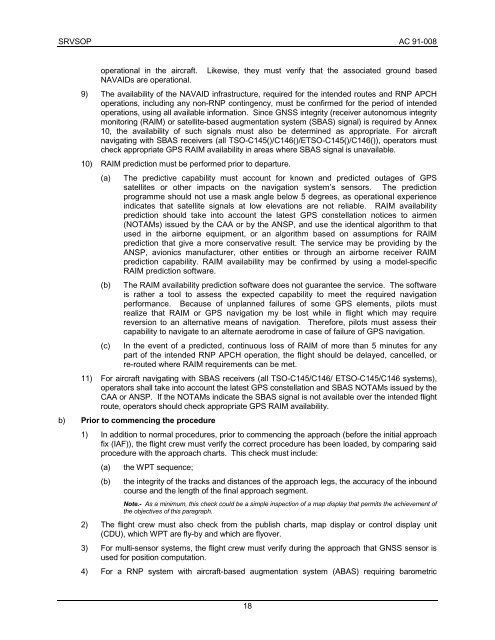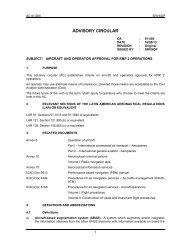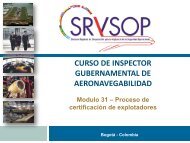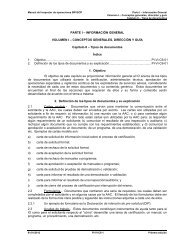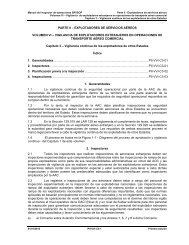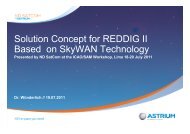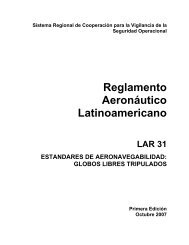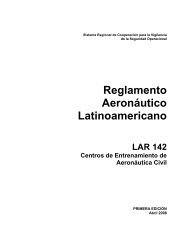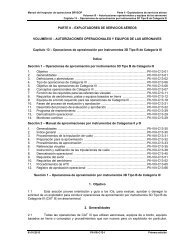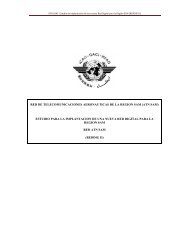CA 91-008 RNP APCH - ICAO
CA 91-008 RNP APCH - ICAO
CA 91-008 RNP APCH - ICAO
You also want an ePaper? Increase the reach of your titles
YUMPU automatically turns print PDFs into web optimized ePapers that Google loves.
SRVSOP AC <strong>91</strong>-<strong>008</strong><br />
operational in the aircraft. Likewise, they must verify that the associated ground based<br />
NAVAIDs are operational.<br />
9) The availability of the NAVAID infrastructure, required for the intended routes and <strong>RNP</strong> <strong>APCH</strong><br />
operations, including any non-<strong>RNP</strong> contingency, must be confirmed for the period of intended<br />
operations, using all available information. Since GNSS integrity (receiver autonomous integrity<br />
monitoring (RAIM) or satellite-based augmentation system (SBAS) signal) is required by Annex<br />
10, the availability of such signals must also be determined as appropriate. For aircraft<br />
navigating with SBAS receivers (all TSO-C145()/C146()/ETSO-C145()/C146()), operators must<br />
check appropriate GPS RAIM availability in areas where SBAS signal is unavailable.<br />
10) RAIM prediction must be performed prior to departure.<br />
(a) The predictive capability must account for known and predicted outages of GPS<br />
satellites or other impacts on the navigation system’s sensors. The prediction<br />
programme should not use a mask angle below 5 degrees, as operational experience<br />
indicates that satellite signals at low elevations are not reliable. RAIM availability<br />
prediction should take into account the latest GPS constellation notices to airmen<br />
(NOTAMs) issued by the <strong>CA</strong>A or by the ANSP, and use the identical algorithm to that<br />
used in the airborne equipment, or an algorithm based on assumptions for RAIM<br />
prediction that give a more conservative result. The service may be providing by the<br />
ANSP, avionics manufacturer, other entities or through an airborne receiver RAIM<br />
prediction capability. RAIM availability may be confirmed by using a model-specific<br />
RAIM prediction software.<br />
(b) The RAIM availability prediction software does not guarantee the service. The software<br />
is rather a tool to assess the expected capability to meet the required navigation<br />
performance. Because of unplanned failures of some GPS elements, pilots must<br />
realize that RAIM or GPS navigation my be lost while in flight which may require<br />
reversion to an alternative means of navigation. Therefore, pilots must assess their<br />
capability to navigate to an alternate aerodrome in case of failure of GPS navigation.<br />
(c) In the event of a predicted, continuous loss of RAIM of more than 5 minutes for any<br />
part of the intended <strong>RNP</strong> <strong>APCH</strong> operation, the flight should be delayed, cancelled, or<br />
re-routed where RAIM requirements can be met.<br />
11) For aircraft navigating with SBAS receivers (all TSO-C145/C146/ ETSO-C145/C146 systems),<br />
operators shall take into account the latest GPS constellation and SBAS NOTAMs issued by the<br />
<strong>CA</strong>A or ANSP. If the NOTAMs indicate the SBAS signal is not available over the intended flight<br />
route, operators should check appropriate GPS RAIM availability.<br />
b) Prior to commencing the procedure<br />
1) In addition to normal procedures, prior to commencing the approach (before the initial approach<br />
fix (IAF)), the flight crew must verify the correct procedure has been loaded, by comparing said<br />
procedure with the approach charts. This check must include:<br />
(a) the WPT sequence;<br />
(b) the integrity of the tracks and distances of the approach legs, the accuracy of the inbound<br />
course and the length of the final approach segment.<br />
Note.- As a minimum, this check could be a simple inspection of a map display that permits the achievement of<br />
the objectives of this paragraph.<br />
2) The flight crew must also check from the publish charts, map display or control display unit<br />
(CDU), which WPT are fly-by and which are flyover.<br />
3) For multi-sensor systems, the flight crew must verify during the approach that GNSS sensor is<br />
used for position computation.<br />
4) For a <strong>RNP</strong> system with aircraft-based augmentation system (ABAS) requiring barometric<br />
18


